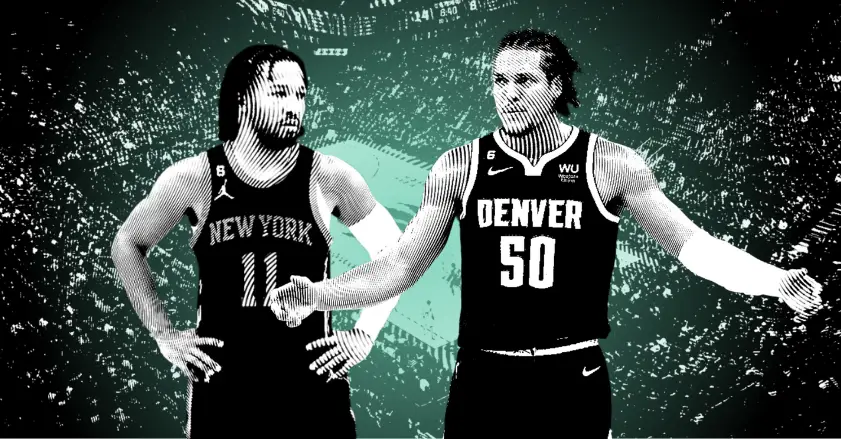19.6
19.6 is the number of midrange (10-19 foot) jumpers that Devin Booker, Chris Paul, and Kevin Durant average per game. For reference, only the Atlanta Hawks shoot more jumpers from those areas as a team.
All three are elite marksmen from those distances (Durant is shooting nearly 60%, a ludicrous figure — a Durant middy is about as good as a Shai Gilgeous-Alexander layup!), and it’s a shot that holds increasing value in the playoffs.
If you miss the steady avalanche of midranges from the 90s and 2000s, you’re about to be in heaven.
It’s fair to say we’ve never seen this collection of midrange shooting talent in the modern NBA. Defenses today try to give up midrange jumpers to clamp down on threes and layups instead, so it’ll be hilarious watching playoff teams contort themselves and fight years of muscle memory to try and get Durant and Booker out of their spots (to say nothing of Paul and fellow midrange maestro TJ Warren!).
111.9
The Denver Nuggets have boasted the sixth-best defensive rating in the NBA since the year started, allowing just 111.9 points per 100 possessions. Combine that with their fourth-ranked offense in that period, and we have half a season of the Nuggets looking like both an unstoppable offense and a shutdown defense. What spurs that?
Say it with me, folks: opponent three-point shooting. Foes have shot just 32.3% from deep against the Nuggets in that stretch, the lowest mark in the league. Denver has a few talented perimeter defenders, but generally speaking, opponent three-point shooting heavily depends on luck. In fact, Denver surrendered the fifth-highest opponent three-point percentage from the start of the season to New Year’s Eve (37.4%)!
This doesn’t mean the Nuggets will suddenly surrender an avalanche of treys in the playoffs, but it does suggest that not all of their defensive improvement is sustainable.
Denver’s offense should be bulletproof, however, so if the Nuggets can simply be a solid defense, they’ll be heavy favorites to at least make the conference championship.
56.7
Don’t look now, but the New York Knicks are sixth in the league in offensive rating. A major reason: they relentlessly attack the rim, averaging 56.7 drives per game (behind only the Thunder).
A similar Knicks squad averaged just 46.9 forays per game last season (despite a half-season of RJ Barrett thinking he was a rim-seeking missile and flinging himself at the hoop with since-forgotten ferocity). The impact Jalen Brunson and his fancy footwork have had on this offense cannot be overstated, and the recent addition of Josh Hart should only help this number.
When was the last time we saw a Knicks point guard who could consistently do this?
The way Brunson uses his pick-and-roll partner’s defender (Corey Kispert, in this case) like a pulling offensive lineman, blocking would-be helpers, is delicious.
It’s weird to see an offense-first Knicks team, but Thibs’ belated rotation changes and Brunson’s steady play have created a bonafide offensive engine. They’ve been even stronger of late on that end, too. Now if they could just figure out the defensive side (18th in the league since the New Year), the Knicks might be ready to make some trouble.
+29
Center Jakob Poetltl has been a cumulative +29 in his three games back with the Raptors, in which Toronto lost to mediocre Utah, won a tight one against desultory Detroit, and beat the feisty-but-overmatched Magic. Of course, individual +/- numbers in small samples are silly to analyze, but they do indicate that Poeltl is positively impacting a previously moribund squad.
I wasn’t a big believer in the trade for Poeltl, and a 2-1 record against three teams with a losing record doesn’t sway me. But Toronto still is in the hunt for a playoff spot, and Poeltl undoubtedly fills a gaping hole. The big man looks re-energized, swatting nine shots in the previous two games, as many as he had in his last 11 games with the Spurs combined.
Jakob even showed off his touch with a season-high 30 points against the Magic by making 15 of 17 attempts. These weren’t just putbacks and dunks, either. Poeltl had several legitimate post-ups that resulted in buckets, and he showed strong decisiveness on the short roll:
Poeltl had moments in San Antonio — a clever pass here, a silky floater there — but was rarely featured enough for me to judge his true offensive ceiling. Toronto is banking on it being more than a flash in the pan.
The Raptors’ half-court offense is horrendous (fourth-worst in the league), and even though a post-up is rarely an efficient play in the long run, it does give the Raptors an escape hatch when their offense inevitably starts sinking.
Most of the trade analysis around Poeltl focused on his potential defensive impact for the Raptors, but few expected him to make an offensive difference. He rarely touched the ball in his first two games with the Raps before his explosion against the Magic, but given Toronto’s struggles putting the ball in the bucket, I’ll be watching closely to see if coach Nick Nurse starts funneling the ball to Poeltl more often.
If you enjoyed this article, please subscribe to basketballpoetry.com to have more delivered directly to your mailbox every Tuesday and Friday! Also, please follow me on Twitter @bballispoetry. Thanks!

